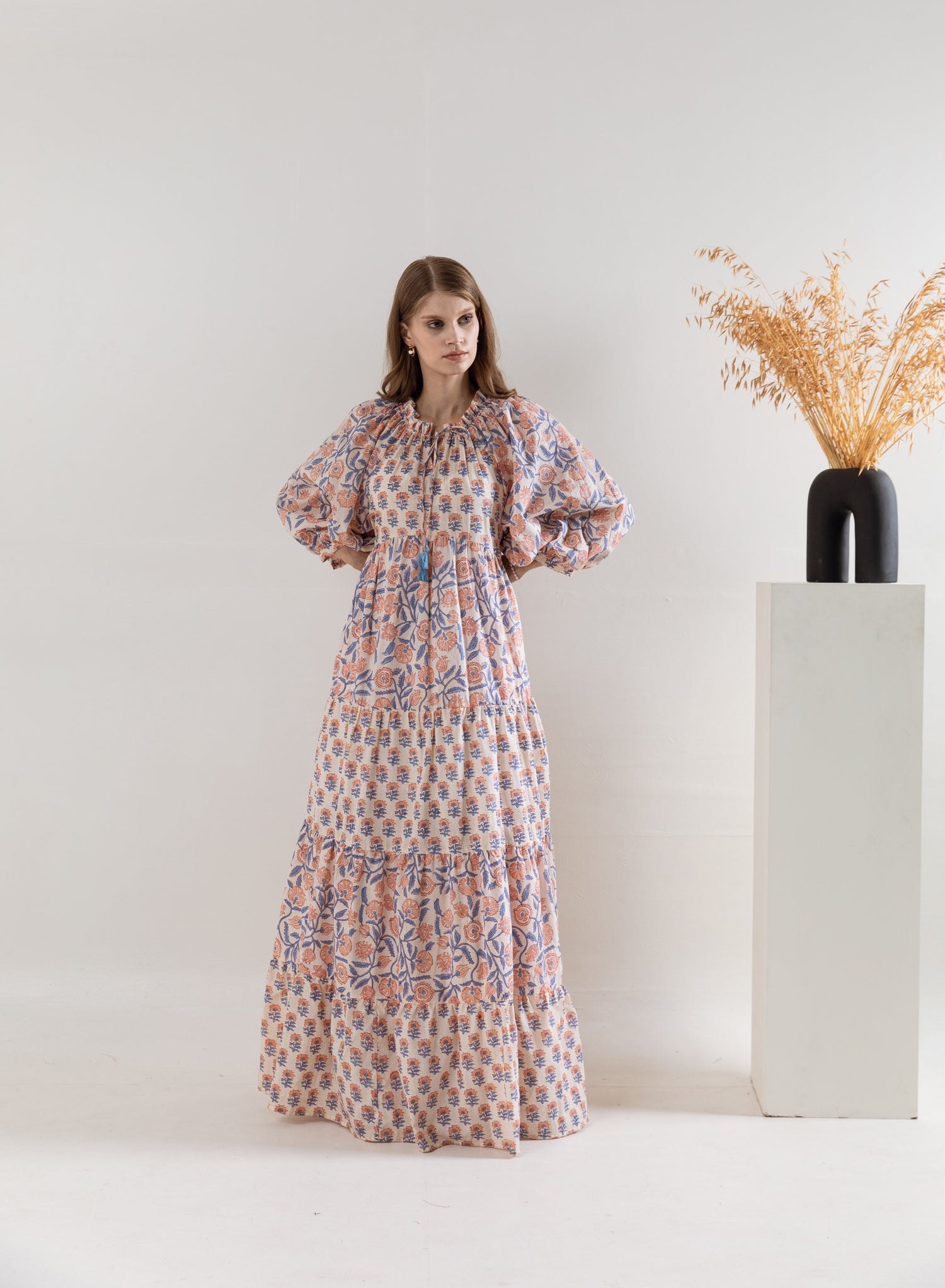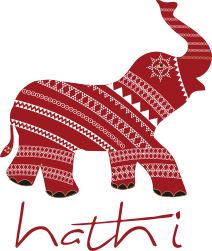In an era where consumers crave sustainable and one-of-a-kind products, hand-block printing is the way to go. Every piece is made more authentic and charming by the variations and flaws in the prints. Having one of these dresses implies that you are sharing a culturally and historically rich tale. Using natural dyes like turmeric, alizarin, and indigo, a captivating palette that embodies Rajasthan is created. The most well-liked Jaipur handblock print designs are floral motifs, geometric patterns, and paisley designs. Let us examine how it originally came to be.
Origins and Cultural Significance of Block Printing

The Birth of Block Printing
During the Tang Dynasty (7th century AD), clever Chinese artisans found a novel way to use wooden blocks to transfer ink onto fabric. The method was groundbreaking and completely changed the textile industry! Block printing was first used on scrolls to reproduce Buddhist texts and elaborate illustrations. But the talented artisans quickly saw that there was a chance to produce beautiful patterns on fabric, and presto! The technique of hand-block printing became central to textile design.
Cultural Threads: Significance and Narratives Woven into Hand-Block Printing
Hand-block printing is a storytelling technique that incorporates cultural narratives into each thread, not just beautiful patterns. Every block conveys a story, be it a folktale, a mythological legend, or an ode to nature. Can you relate?
Each motif on a fabric printed by hand blocks carries a message. Whether it is the symbolic lotus or the auspicious peacock, these motifs communicate with the wearer through a visual language that links them to a more profound cultural story.

The Process of Hand-Block Printing
Design Creation
- Craftspeople with advanced skills create complex patterns for printing by hand.
- Nature, folklore, and cultural narratives are common sources of inspiration for designers.
Wooden Block Carving
- Artists carve patterns into wooden blocks to make printing stamps.
- Every block is a painstaking little work of art that demonstrates skill and accuracy.
Fabric Selection
- Carefully chosen fabrics, often 100% natural-dyed soft cotton, serve as the canvas for printing.
- The fabric's texture and quality play a crucial role in the outcome.
Natural Dyes Preparation
- Natural dyes are made by artisans with plant-based ingredients, guaranteeing a sustainable process.
- The color scheme reflects the depth of color found in nature.
Our dresses are made from soft cotton that has only been naturally dyed, with an emphasis on sustainability and comfort. Using natural dyes not only guarantees a soft touch on your skin but also demonstrates our dedication to protecting the environment.
Block Printing Process
- The prepared natural dyes are dipped into wooden blocks.
- The blocks are then precisely stamped onto the fabric by the artisans.
As the design develops, the pattern that is produced by this iterative process is captivating. The actual allure of handmade art can be found in the imperfections of block printing. Unlike cheap, machine-printed alternatives, each flaw in our dresses is a tribute to the hands that created them.
Drying and Fixing
- Printed materials are allowed to air dry so that the colors can settle organically.
- To guarantee colorfastness and durability, fixing agents can be used.
Final Touches
- Any extra accents or detailing are applied by hand, displaying the unique touch of the artisan.
- To guarantee perfection, the finished product is put through quality checks.
Crafted with Precision: Unraveling the Intricate Process of Hand-Block Printing
Our Soyah Tier ruffle dresses honor a legacy that spans generations while showcasing the unmatched skill of Indian artisans. Each creation offers you a special window into the diverse spectrum of Indian artistry and is a monument to their commitment and talent.
The Charm of Imperfection
Irregularities create a sense of movement and organic beauty in the patterns.
Human Touch vs. Machine
Precision at a Cost
- While machines are incredibly precise, they frequently lack the warmth and individuality of handcrafted goods.
- Repetition reduces uniqueness because it causes uniformity.

Mass Production Challenges
- Some people find that their uniqueness is lost in the homogeneity of machine-made prints.
- The soulful charm that results from the slight variations in hand-block printing may be absent from flawless replicas.
Creative Restrictions
- Artistic experimentation is limited because machines adhere to predetermined patterns and designs.
- With every new piece created using hand-block printing, one can express creativity and adapt.
Character and Value: How Imperfections Elevate Each Hand-Block Printed Piece

Revival and Sustainability
The beauty of imperfections is what hand-block printing thrives on. At Hathi, our goal is to give Middle Eastern women access to durable, fashionable, and eco-friendly clothing options. Picture it this way. You get to wear history on your sleeve.
Local Artisans, Global Impact
Sustainability is about fair practices as much as materials. By guaranteeing that their skills are respected and their working conditions are moral, hand-block printing gives local artisans a sense of empowerment. This benefits communities in addition to maintaining traditional craftsmanship.
Circular Fashion
Hand-block printing promotes circular fashion in a world where fast fashion rules. It opposes the disposable culture by creating classic pieces with enduring appeal and encourages customers to treasure and re-wear their hand-block-printed treasures.
Contemporary Adaptations and Global Influence
Modern designers have embraced hand-block printing, infusing it with a fresh perspective. The Felis Balloon Crown Dress available at Hathi Store, is a stellar example. Its silhouette, adorned with intricate hand-block prints, effortlessly merges the nostalgia of the craft with contemporary style.
Global Threads: The Traditional Craft's Impact on Today's Global Design Scene

Hand-block printing is becoming more and more popular in the world of design because of its inherent authenticity and cultural legacy. But why is that? This craft, which has been passed on through the generations, honors traditional skills and provides a special connection to the past. The Pin Tuck Dress at Hathi Store, with its imperfections, becomes a wearable canvas of tales and traditions.
Through their global collaborations with artisans, modern designers are introducing these age-old methods to a wider audience. This promotes appreciation for a variety of artistic expressions and cross-cultural interchange, in addition to helping local communities and protecting cultural heritage.
Designers today are doing more than just copying old techniques. They are also pushing the limits of hand-block printing and producing modern designs with a distinct aesthetic by experimenting with new materials, methods, and color schemes.
Furthermore, hand-block printing's sustainable qualities are becoming more well-known. Hand-block printing is a low-tech method that uses natural dyes and organic materials, in contrast to mass production methods, which often have a significant environmental impact. The environmentally conscious consumers of today can relate to this eco-conscious approach.
Community and Government Initiatives: Valuable Support Systems
Hand-block printing is actively supported and promoted by NGOs such as Culturally Ours and Indolibas. And the best part? They help artisans market their products, put them in touch with potential customers, and fight to uphold fair trade standards.
Governments are starting to understand how important it is to keep this kind of art alive. They are starting skill development centers, giving tax breaks to companies that sell hand-block printed goods, and supporting artisan communities financially.
The truth is this .By appreciating its distinctive features and favoring hand-printed goods over mass-produced substitutes, consumers can significantly contribute to the continued existence of hand-block printing. Acknowledging the artistic merit and cultural relevance of hand-block printing motivates makers to pursue their trade and promotes conscientious consumption.
We can protect our cultural legacy for future generations and preserve a beautiful art form by placing a high value on hand-block printed goods. We can also support the livelihoods of talented artisans.
Conclusion
Our dedication to exhibiting Hathi Store's unmatched craftsmanship stems from our appreciation of Jaipur's rich cultural legacy. Our store serves as a link between the past and the present, conserving and promoting artisan clothing techniques that have been handed down through the generations. The city has long been a stronghold of artisanal excellence.
Come celebrate the timeless charm of Indian textile artistry with us, and help us preserve this priceless cultural legacy. Let us unite to honor the creators of hand-block printing as well as their artistic beauty.


